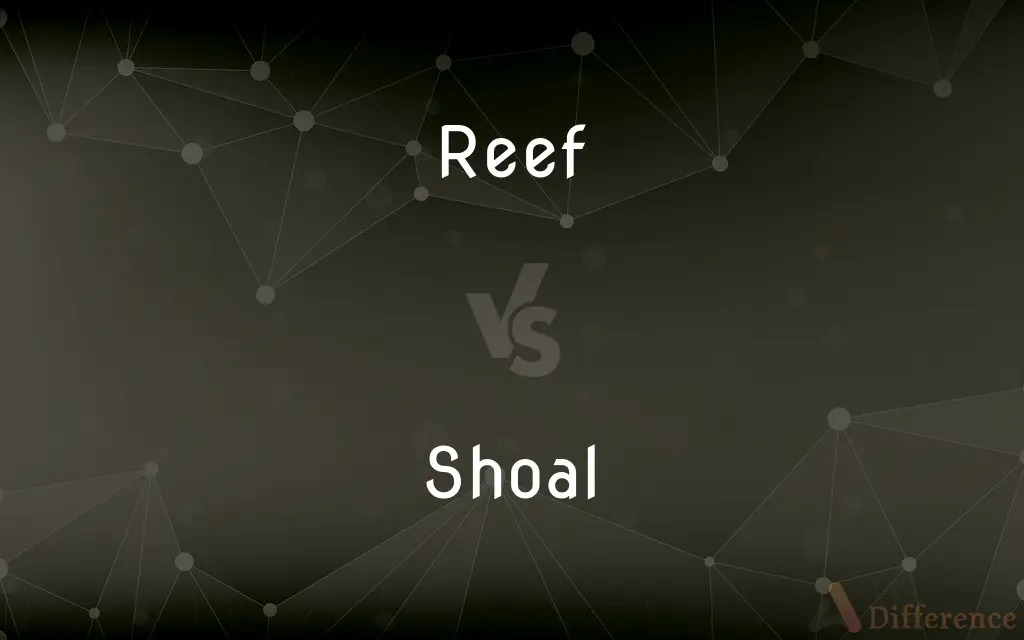Reef vs. Shoal — What's the Difference?
By Urooj Arif & Fiza Rafique — Updated on March 12, 2024
Reefs are underwater structures made of coral or rock, while shoals are natural sandbanks or shallow areas in water.

Difference Between Reef and Shoal
Table of Contents
ADVERTISEMENT
Key Differences
Reefs are underwater ecosystems formed by the accumulation of coral or rock, often teeming with marine life. These structures can be found in both shallow and deep waters and are known for their biodiversity. Coral reefs, in particular, are made from the calcium carbonate skeletons of coral organisms and are often found in warm, shallow waters of tropical oceans. Shoals, on the other hand, refer to natural sandbanks or shallow areas in bodies of water, created by the accumulation of sand, silt, or other sediment. Shoals can be found in oceans, rivers, and lakes, and their size and shape can change over time due to currents, tides, and the movement of sediment.
Reefs provide critical habitats for a wide range of marine species and serve as natural barriers protecting coastlines from erosion and storm surges. While shoals may not have the same biodiversity as coral reefs, they are important for coastal ecosystems, serving as habitats for various aquatic plants and animals, and can also affect water navigation by creating hazardous areas for boats and ships.
One of the key differences between reefs and shoals is their composition. Reefs are primarily biological in origin, built over time by living organisms, whereas shoals are geological features formed by the accumulation of sediment. This distinction highlights the contrasting nature of their formation and the ecosystems they support.
While both reefs and shoals can present navigational hazards, their impact on marine navigation and ecosystems differs. Reefs, with their rigid structures, can pose a significant threat to vessels, whereas shoals, with their shifting sands, can create unpredictable shallow waters. Despite these hazards, both features are vital to their respective environments, offering protection and habitats that contribute to the ecological balance of marine and coastal areas.
Reefs and shoals are distinct maritime features, each playing unique roles in their environments. Reefs are notable for their complex ecosystems and role in protecting coastlines, while shoals are characterized by their sedimentary nature and influence on aquatic habitats and navigation.
ADVERTISEMENT
Comparison Chart
Composition
Made of coral or rock, often biological in origin.
Consists of sandbanks or sediment, geological in nature.
Habitat
Supports diverse marine life, forming complex ecosystems.
Provides habitats for aquatic plants and animals, though less biodiverse than reefs.
Location
Found in both shallow and deep waters, often in tropical regions.
Located in oceans, rivers, and lakes, influenced by currents and sediment movement.
Navigational Impact
Can pose significant hazards to vessels due to their rigid structures.
Creates shallow waters, affecting navigation and posing risks to boats and ships.
Environmental Role
Protect coastlines from erosion and storm damage, support marine biodiversity.
Influence aquatic ecosystems, can change shape and size, affecting water flow and habitats.
Compare with Definitions
Reef
A submerged ridge of rock or coral near the surface of the water.
The Great Barrier Reef is the largest coral reef system in the world.
Shoal
A shallow area in a body of water, caused by a sandbank or sediment accumulation.
Navigators must be wary of shoals that can ground ships.
Reef
Home to diverse marine ecosystems, supporting thousands of species.
Reefs provide breeding grounds for many fish species crucial to fishing industries.
Shoal
Serves as a habitat for various water birds, fish, and plant life.
Shoals provide feeding grounds for birds and nursery areas for fish.
Reef
Important for marine research and biodiversity conservation.
Scientists study reefs to understand marine biodiversity and ecosystem dynamics.
Shoal
May form islands or extend existing landmasses when sediment builds up.
Some islands started as shoals, accumulating sediment over time.
Reef
Acts as a barrier against erosion and storms, protecting coastlines.
Coral reefs can dissipate wave energy, reducing the impact of storms on shorelines.
Shoal
Can appear and shift with tides and currents, altering waterways.
Shoals in river deltas can change rapidly, affecting navigation routes.
Reef
Vulnerable to environmental threats like bleaching and climate change.
Rising sea temperatures have led to widespread bleaching of coral reefs.
Shoal
Influences the hydrodynamics of water bodies, affecting erosion and deposition patterns.
Shoals can redirect water flow, impacting nearby ecosystems.
Reef
A reef is a ridge or shoal of rock, coral or similar relatively stable material, lying beneath the surface of a natural body of water. Many reefs result from natural, abiotic processes—deposition of sand, wave erosion planing down rock outcrops, etc.—but there are also reefs such as the coral reefs of tropical waters formed by biotic processes dominated by corals and coralline algae, and artificial reefs such as shipwrecks and other anthropogenic underwater structures may occur intentionally or as the result of an accident, and sometimes have a designed role in enhancing the physical complexity of featureless sand bottoms, to attract a more diverse assemblage of organisms.
Shoal
In oceanography, geomorphology, and geoscience, a shoal is a natural submerged ridge, bank, or bar that consists of, or is covered by, sand or other unconsolidated material and rises from the bed of a body of water to near the surface. It often refers to those submerged ridges, banks, or bars that rise near enough to the surface of a body of water as to constitute a danger to navigation.
Reef
A strip or ridge of rocks, sand, or coral that rises to or near the surface of a body of water.
Shoal
A shallow place in a body of water.
Reef
A vein of ore.
Shoal
A sandy elevation of the bottom of a body of water, constituting a hazard to navigation; a sandbank or sandbar.
Reef
Chiefly Western US A long craggy ridge or rocky escarpment.
Shoal
A large school of fish or other aquatic animals.
Reef
A portion of a sail gathered in and secured to lessen the area exposed to the wind.
Shoal
A large group; a crowd
A shoal of advisers.
Reef
To reduce the size of (a sail) by gathering in a part and securing it, as by lashing it to a yard.
Shoal
To become shallow
The river shoals suddenly here from eight to two fathoms.
Reef
To shorten (a topmast or bowsprit) by taking part of it in.
Shoal
To make shallow
The approach to the harbor was shoaled in the storm.
Reef
A chain or range of rocks, sand, or coral lying at or near the surface of the water.
Shoal
To come or sail into a shallower part of.
Reef
A large vein of auriferous quartz; hence, any body of rock yielding valuable ore.
Shoal
To come together in large numbers
The fish were shoaling.
Reef
(nautical) A portion of a sail rolled and tied down to lessen the area exposed in a high wind.
Shoal
Having little depth; shallow.
Reef
A reef knot.
Shoal
Shallow.
Shoal water
Reef
The itch; any eruptive skin disorder.
Shoal
A sandbank or sandbar creating a shallow.
Reef
Dandruff.
Shoal
A shallow in a body of water.
Reef
(nautical) To take in part of a sail in order to adapt the size of the sail to the force of the wind.
Shoal
Any large number of persons or things.
Reef
(Australian) To pull or yank strongly, especially in relation to horse riding.
Shoal
(collective) A large number of fish (or other sea creatures) of the same species swimming together.
Reef
To move the floats of a paddle wheel toward its center so that they will not dip so deeply.
Reef the paddles.
Shoal
To arrive at a shallow (or less deep) area.
Reef
(slang) To manipulate the lining of a person's pocket in order to steal the contents unnoticed.
Shoal
(transitive) To cause a shallowing; to come to a more shallow part of.
Reef
Scabby; scurvy.
Shoal
To become shallow.
The colour of the water shows where it shoals.
Reef
A chain or range of rocks lying at or near the surface of the water. See Coral reefs, under Coral.
Shoal
To collect in a shoal; to throng.
The fish shoaled about the place.
Reef
A large vein of auriferous quartz; - so called in Australia. Hence, any body of rock yielding valuable ore.
Shoal
A great multitude assembled; a crowd; a throng; - said especially of fish; as, a shoal of bass.
Beneath, a shoal of silver fishes glides.
Reef
That part of a sail which is taken in or let out by means of the reef points, in order to adapt the size of the sail to the force of the wind.
Shoal
A place where the water of a sea, lake, river, pond, etc., is shallow; a shallow.
The depth of your pond should be six feet; and on the sides some shoals for the fish to lay their span.
Wolsey, that once trod the ways of glory,And sounded all the depths and shoals of honor.
Reef
To reduce the extent of (as a sail) by rolling or folding a certain portion of it and making it fast to the yard or spar.
Shoal
A sandbank or bar which makes the water shoal.
The god himself with ready trident stands,And opes the deep, and spreads the moving sands,Then heaves them off the shoals.
Reef
A submerged ridge of rock or coral near the surface of the water
Shoal
To assemble in a multitude; to throng; as, the fishes shoaled about the place.
Reef
A rocky region in the southern Transvaal in northeastern South Africa; contains rich gold deposits and coal and manganese
Shoal
To become shallow; as, the color of the water shows where it shoals.
Reef
Lower and bring partially inboard;
Reef the sailboat's mast
Shoal
To cause to become more shallow; to come to a more shallow part of; as, a ship shoals her water by advancing into that which is less deep.
Reef
Roll up (a portion of a sail) in order to reduce its area
Shoal
Having little depth; shallow; as, shoal water.
Reef
Reduce (a sail) by taking in a reef
Shoal
A sandbank in a stretch of water that is visible at low tide
Shoal
A stretch of shallow water
Shoal
A large group of fish;
A school of small glittering fish swam by
Shoal
Make shallow;
The silt shallowed the canal
Shoal
Become shallow;
The lake shallowed over time
Common Curiosities
What is a reef?
A reef is an underwater structure, often made of coral or rock, that supports a diverse range of marine life.
How do reefs benefit the environment?
Reefs protect coastlines from erosion and storms, support marine biodiversity, and serve as vital habitats for numerous species.
Can reefs be found in cold waters?
Yes, while coral reefs are more common in warm, tropical waters, certain types of reefs, like deep-sea coral reefs, can be found in colder waters.
How does a shoal form?
Shoals form from the accumulation of sediment like sand or silt in bodies of water, influenced by currents and tides.
Can human activities affect reefs and shoals?
Yes, human activities like pollution, dredging, and climate change can negatively impact both reefs and shoals, altering their structures and ecosystems.
What is the difference between a shoal and a sandbar?
Shoals and sandbars are similar, both being shallow areas or accumulations of sediment, but sandbars are more likely to be near the shore or surface.
How are shoals detected and monitored?
Shoals are often monitored using sonar, satellite imagery, and nautical charts to ensure safe navigation and understand environmental changes.
Are there efforts to protect reefs and shoals?
Yes, there are numerous conservation efforts aimed at protecting reefs and shoals, recognizing their importance for biodiversity and coastal protection.
Are all shoals hazardous to navigation?
While many shoals can present navigational challenges, not all are hazardous, and their impact can vary with changes in sediment and water levels.
Can shoals become land?
Over time, and with enough sediment accumulation, shoals can grow above the waterline, potentially becoming new landmasses or islands.
How do reefs and shoals differ in their impact on ecosystems?
Reefs are vital for marine ecosystems due to their biodiversity, while shoals influence aquatic habitats and can affect water flow and sediment distribution.
What role do reefs play in tourism?
Reefs, especially coral reefs, are popular destinations for tourism activities like snorkeling and diving, contributing to local economies.
Why are coral reefs important for marine life?
Coral reefs provide food, shelter, and breeding grounds for an immense variety of marine organisms, making them crucial for marine biodiversity.
How do climate changes affect reefs and shoals?
Climate changes, including rising sea temperatures and altered currents, can lead to coral bleaching and changes in shoal formations, affecting their roles in ecosystems.
Can shoals be man-made?
While most shoals are natural, human activities like dredging and construction can create artificial shoals or alter existing ones.
Share Your Discovery

Previous Comparison
Approach vs. Model
Next Comparison
Socialism vs. CorporatismAuthor Spotlight
Written by
Urooj ArifUrooj is a skilled content writer at Ask Difference, known for her exceptional ability to simplify complex topics into engaging and informative content. With a passion for research and a flair for clear, concise writing, she consistently delivers articles that resonate with our diverse audience.
Co-written by
Fiza RafiqueFiza Rafique is a skilled content writer at AskDifference.com, where she meticulously refines and enhances written pieces. Drawing from her vast editorial expertise, Fiza ensures clarity, accuracy, and precision in every article. Passionate about language, she continually seeks to elevate the quality of content for readers worldwide.














































